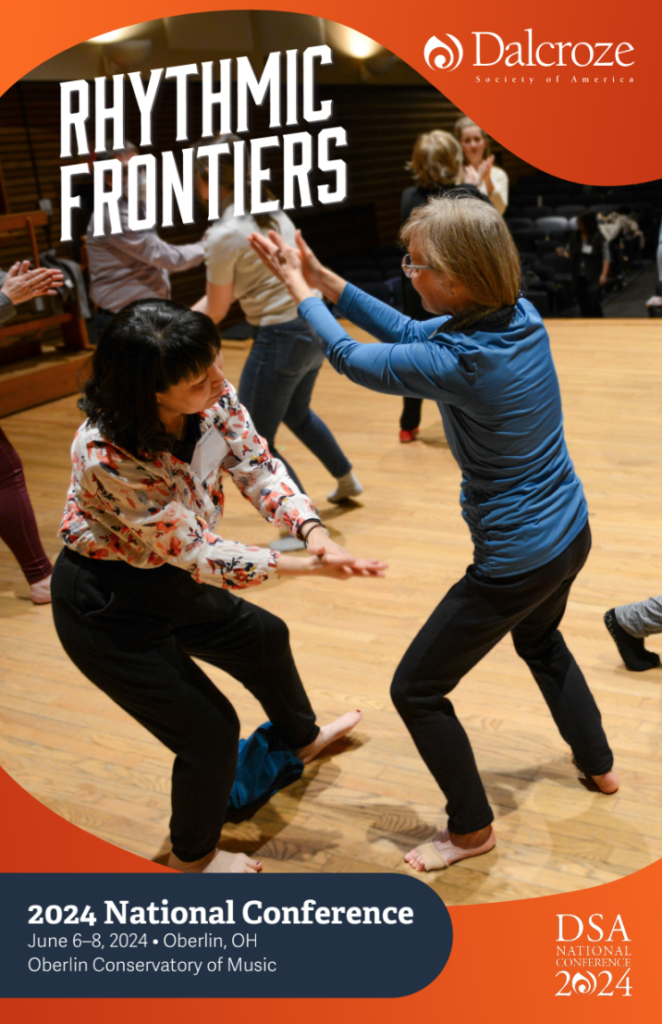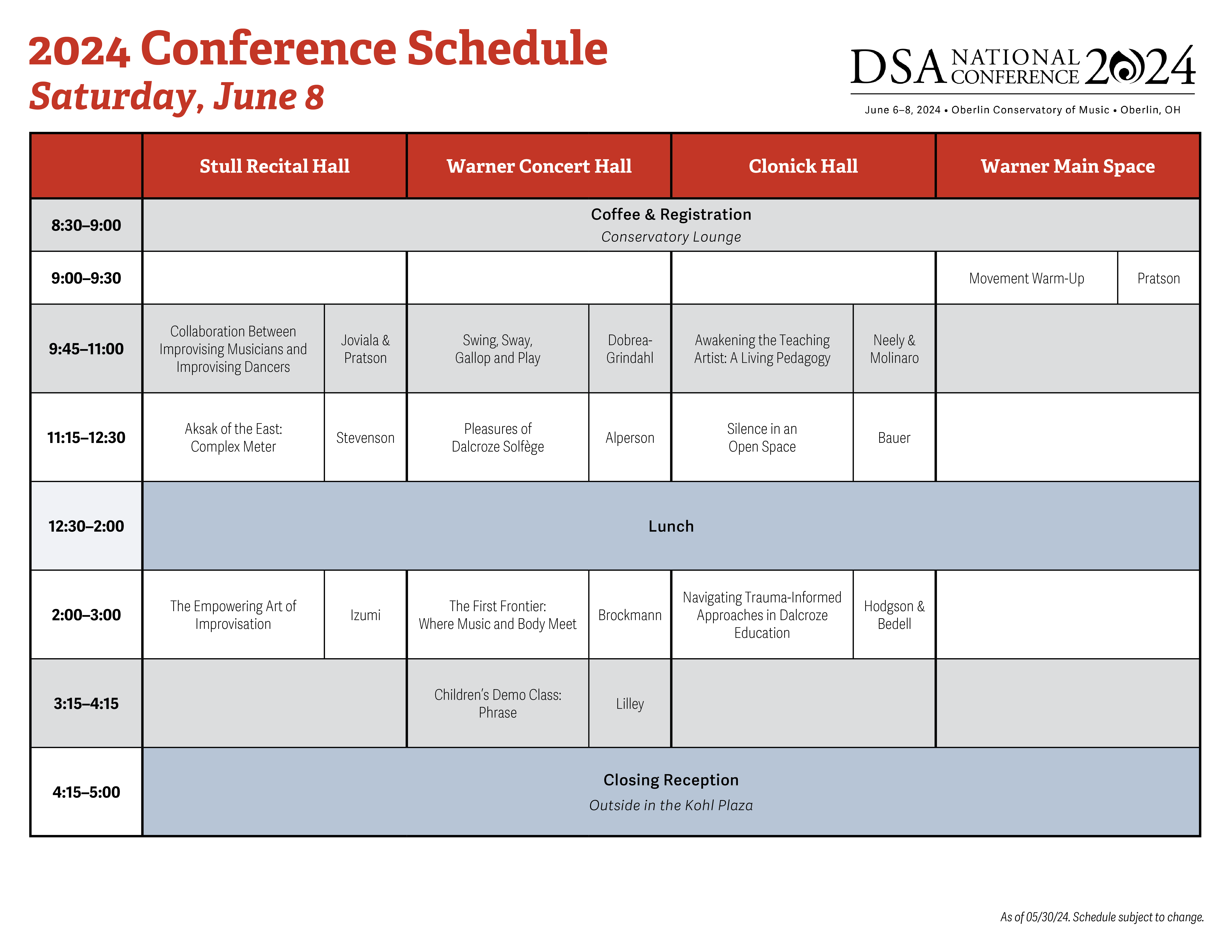Schedule and Presenters

The 2024 Conference will welcome 27 presenters from the United States and around the world to share their experience and knowledge with attendees.
Conference Schedule
Session Descriptions
Read a preview of the upcoming presentations at the conference. (Subject to change.)
Special Sessions: Dalcroze 101–104
Dalcroze 101–104 are for newcomers to the Dalcroze method or for anyone looking for an overview of the strategies/techniques of the practice.
Dalcroze 101: Introduction to Eurhythmics
Gregory Ristow
Eurhythmics builds a trained synesthesia between music and movement, allowing us to both teach and learn through either medium. In this introductory eurhythmics lesson, we’ll explore qualities of movement and sound as we dive into the classic Dalcrozian concept of time, space, and energy.
Dalcroze 102: Aesthetic Education through Purposeful Movement
Jeremy Dittus
This session explores how purposeful movement can support an aesthetic education. Through Dalcrozian principles, strategies, and techniques, we can deepen our understanding of musicianship, inform our musical intuition, and nurture creativity. Let’s move!
Dalcroze 103: Rhythmic Revelations: The Untapped Potential of the Duplet
Lauren Hodgson
Join us for an immersive session where participants will delve into a captivating exploration of compound meter. We will investigate the sensation of compound meter within the body, unraveling the intricate dance where time, space, and energy converge to unveil the mesmerizing and untapped potential of the duplet.
Dalcroze 104: Dalcroze Solfège and Harmony
Eiko Ishizuka
Using embodied approaches to ear training, we’ll learn “Che Gusto” by Antonio Caldara, which employs the harmonic progression of descending 5ths. We remember beloved Dalcroze teacher Lisa Parker in this class, who adored this canon.
Session Descriptions
Alphabetical by presenter last name.
Children’s Demo Class: Moving to Learn
Ruth Alperson
Observe keynote presenter and Dalcroze expert Ruth Alperson (Diplôme Supérieur) teach a song that the children will enjoy learning: “Under the Chestnut Tree.” While the children move and sing, they will embody the concept of “phrase,” eventually transitioning from moving the phrase to freely "notating" the phrase.
Pleasures of Dalcroze Solfège: Melodizing, Harmonizing, Improvising
Ruth Alperson
Among Jaques-Dalcroze’s greatest legacies are unique exercises and strategies that he used in teaching sight singing and ear training. In general, movement allied with singing clarifies structures that some of us may learn at first, analytically, via music theory. Movement allied with singing makes the learning easier for many—and it is enjoyable.
Flamenco Sketches and Modal Harmony
William R. Bauer
Miles Davis’s solo on the track “Flamenco Sketches” from Kind of Blue has not been surpassed for its beauty. We will study it through solfège to unlock some of its modal secrets.
Silence in an Open Space
William R. Bauer
Silence holds a special place in Eurhythmics. The key to inner hearing, it enables us to feel music in the absence of music. The sensations of inwardly felt rhythms, melodies, harmonies, etc., become all the more present to us in silence. Let’s explore silence through movement and stillness.
I Can See Freedom: Past, Present, Future
Terry Boyarsky & Melissa Tucker
Delving into the contemporary song “I Can See Freedom” by African American composer Walter Robinson, we experience crusis/anacrusis and syncopation. Embracing how profoundly rhythm can connect us, we bridge past, present and future. Pushing against rhythmic boundaries, we strive to experience a frontier of freedom.
The First Frontier: Where Music and Body Meet
Nicole Brockmann
For new Dalcroze students, the first strange frontier is often using the body in perceiving and making music. Social and musical anxieties abound! This session invites new and experienced Dalcrozians to (re)discover the joys and erase the initial anxieties of a body-focused musical practice for themselves or for students.
A Cappella Arranging via Dalcroze Solfège Games
Katie Couch
In this 75-minute session, participants will be led to discover and perform a 4-part arrangement of a Marvin Gaye song through Dalcrozian solfège games.
¡Clave!
Katie Cross
Come explore games and strategies for exposure to (and/or mastery of) “clave,” the rhythm at the basis of much of West Africa’s traditional music and the musical genres of the Caribbean and South America! Time permitting, this workshop will include the version most familiar to Western audiences and other versions.
What’s Next?! Teaching Intermediate-Level Rhythmic-Solfège
Jeremy Dittus
What happens after we say, “Hello?” How do we help students reach past the introductory, basic understanding of rhythm and pitch and go further into understanding tonal relationships, intervals, meters, nuances, and more complicated rhythmic patterns? In this hands-on, dynamic pedagogy session, we’ll show how embodied knowledge can create powerful learning experiences for youth; participants will walk away with new inspiration for the Dalcroze hall!
Time Signatures: Fact or Fiction?
Mary Dobrea-Grindahl
What we see in a musical score doesn’t always align with what we hear and feel in music. This eurhythmics class will explore how rhythm, harmonic impulse, and melodic contour influence what we hear and how we move and the ways these elements combine to inform our artistic interpretation.
Swing, Sway, Gallop, and Play
Mary Dobrea-Grindahl
This improvisation class will focus on playing for movement in compound meter. We will explore ways to use harmony, articulation, melodic contour, and pedal to inspire students to sway, run, skip, and gallop. This class will offer ideas for participants at any level of mastery in improvisation.
Navigating Trauma-Informed Approaches in Dalcroze Education
Lauren Hodgson & Adrienne Bedell
Embark on a transformative exploration of trauma-informed Dalcroze education, delving into research-based strategies for trauma-informed classrooms and fostering somatic awareness. In the spirit of “Rhythmic Frontiers,” join us to navigate uncharted territories in sound and motion, interweaving Dalcroze teaching strategies for a holistic journey along rhythmic pathways.
Round/Spiky and/or More
Eiko Ishizuka
Experience groups of 2s, 3s, 4s to feel their quality of movement. Students will deal with balance of the body to learn how 3 against 4 feels in the body, with applications for repertoire.
The Empowering Art of Improvisation
Mari Izumi
In this presentation, I will share video recordings of my Dalcroze class for older students, ages 10–14 (most are violinists). I will show how I introduce and develop instrumental improvisation and demonstrate how it supports and enhances students’ performance skills. Through improvising, students open up; it empowers their musicianship.
Baroque Dancing
Qin Ying Tan
Dr. Qin Ying Tan, lecturer in harpsichord at Baldwin Wallace University, leads a session on Baroque dance. Dr. Tan has earned degrees from Yong Siew Toh Conservatory of Music, the Peabody Institute of Music, and the Cleveland Institute of Music. A firm believer of storytelling through music, Tan draws from a diverse pool of influences such as Baroque French court dance, Indonesian gamelan music, Chinese guzheng practice, as well as community song and dance.
Collaboration Between Improvising Musicians and Improvising Dancers
Michael Joviala & Dawn Pratson
Come rehearse the unknown with Dawn and Michael. Sound makers and movers of all levels and backgrounds gain experience listening, reacting, choosing, shaping and creating with each other. Bring your instruments!
Dynamic Di-chords
Michael Joviala
An entire session devoted to the small but mighty di-chord. We’ll use this fundamental building block to add more swing to your jazz phrasing, expressive ornaments to your melodic toolbox, and just the right amount of tension for your harmonic color wheel.
Children’s Demo Class: Phrasing
Cynthia Lilley
Observe Dalcroze in action with 8–10 year olds! This eurhythmics class will showcase students of Lauren Hodgson led by the deft and musical Cynthia Lilley.
Games and Songs in Five
Anthony Molinaro
Conventional wisdom holds that meters of five are somehow inherently more difficult than meters of two, three, four, or six. In this session, participants will experience a series of games and songs that connect young children to uneven meters and encourage them to groove naturally with these patterns!
Awakening the Teaching Artist: A Living Pedagogy
Stephen Neely & Anthony Molinaro
How does one balance between “lesson planning,” something prepared in advance, with “lesson ideation,” the inventing, creating, and varying of our lessons in the moment to the specific needs of our students. This session will share tools for designing lessons that are creative, productive, and rewarding for both student and teacher.
The Tempo of You: Entrainment and Empathy in the Act of Being Music
Stephen Neely
In this 75-minute collaboration, we will explore the idea of a personal inner tempo and then consider the challenge of “being music” that is at tempos more-than and less-than our authentic selves. How am I to feel the reality of another? With examples from Bach, Dvorák, and Satie, we will consider the difference between playing the notes of and being the music of another.
Plastique Animée: From Analysis of a Musical Work to Aesthetic Experience
Anetta Pasternak, Wiktoria Jańczyk & Anna Morawiec
During the workshop, we will take a closer look at the successive stages of working on plastique animée, starting with exercises to raise awareness of metro-rhythmic issues realized through simple means used in eurhythmics classes, up to improvisation and the search for creative interpretation.
Movement Warm-up (Day 1 & 3)
Dawn Pratson
Start the morning with a thorough, full-body movement class to refresh, awaken, and enliven your soul.
Diversity, Equity & Inclusion Committee Roundtable
Dawn Pratson, chair
Join us for a casual conversation with the DSA DEI Committee. We will share insights and hold an open forum for questions and comments.
Movement Warm Up (Day 2)
Brian Schultis
Start the morning with a movement warm-up drawn from Schultis’s work as a certified Laban Movement Analyst.
Introduction to Contact Improv
Brian Schultis
Contact Improvisation is a form of improvised partner dance that explores elements of balance, falling, and sharing weight. Contact had its birth at Oberlin in 1972. This class for movers of all experience levels and ability will invite movers into a practice designed to help us embrace connections, spontaneity, and awareness of one another.
Aksak of the East: Complex Meter
John Stevenson
Explore the aksak as we dance additive and isochronic beat structures defined by Constantin Brăiloiu (1893–1958), a Romanian and Geneva resident who worked at the Musée d'ethnographie de Genève and as an assistant professor (maître de conférence) at the CNRS in Paris, and dive into a whole new rhythmic frontier, forging complex meters.
Polyrhythmic Frontiers
Brian Sweigart
Polyrhythm has long been a core concept in eurhythmics. During this presentation, we will explore why it is beneficial for students to study polyrhythm through movement, from simply learning the rhythm to utilizing polyrhythmic skills in the frontier of contemporary music.
Explore Rhythmic Frontiers through Improvisation
Leslie Upchurch
The landscape of the piano is rich with rhythmic possibilities. My workshop will open up the many possibilities that any level of pianist can explore. This exploration is the gateway to a teaching style that is a new frontier for many. We will even ride with The Old Cowboy into new harmonic territory. This is one improvisation experience everyone remembers and recognizes when they hear it!
Special Events
Keynote & Lifetime Achievement Award
Ruth Alperson
With special introductory performances by Michael Joviala, Dawn Pratson, Anetta Pasternak, Wiktoria Jańczyk, and Anna Morawiec
In her keynote address, Ruth Alperson remembers her time as a student with Inda Howland, the first American woman to receive the Diplôme Supérieur. Howland taught at Oberlin from 1940–1974. As Ruth writes, “My introduction to eurhythmics was at Oberlin, in 1969, with Professor Inda Howland, one of the great pedagogues in my lifetime. Howland's work was inspiring. Her course sent me on a career path, in Dalcroze eurhythmics. The path now turns back to Oberlin, to this DSA conference, where I celebrate Inda Howland through stories, and an exercise inspired by her work.”
Dalcroze Society of America General Meeting
DSA Board of Trustees
Hosted by the Dalcroze Society of America Board of Trustees, this meeting and presentation is your chance to learn about our organization and make your voice heard. The meeting will include a special message from the Institut Jaques-Dalcroze. All are welcome to attend.
All-Conference Banquet
Experience an exceptional evening at our All-Conference Banquet! Enjoy a special meal and connect with friends and colleagues from across the practice. Please note that the banquet is a ticketed event ($49). Tickets can be purchased when registering. A variety of dining choices will be available, including vegan and gluten-free options.
Closing Reception
Say au revoir to your Dalcroze friends with song, dance, and refreshments.
All-Conference Picnic & Underground Railroad Center Event
Join us at the Oberlin Gasholder Building to enjoy an all-conference picnic catered by the Arb at Oberlin. We’ll also experience a newly commissioned, site-specific work by dance and theater artists Desmond Davis and Robin Pease. Along with the performance, representatives from the Oberlin Heritage Center will give a brief presentation on Oberlin’s connection to the Underground Railroad. A variety of dining choices will be available, including vegan and gluten-free options.
The Price of Laws: 1856 and 2024
During the Civil War, the law demanded enslaved people who fled be forcibly returned to their masters. This happened right here in Oberlin, Ohio. The law discriminated. Does it still? What price do we, the people, pay when the law is inherently prejudicial? What do we do when those in positions of privilege and power make laws that take away human rights and equality? What is the price of freedom?
Short Presentations
Short Presentations #1
Rhythm, Pitch, and Gesture
Ji Hyun Woo
This presentation outlines a method for incorporating kinesthetic movement into college-level music theory classes, guided by Dalcroze's pedagogical principles. Specific examples, including canon, improvisation, and eEurythmics illustrate how this approach engages auditory, visual, and kinesthetic dimensions for effective musical training.
Child’s Play: Ear Training with Children
Anetta Pasternak
Participants will take part in music and movement exercises involving voice, hearing, and motion during this short workshop. Early childhood pedagogy should take into account polysensory methods, as children at this stage develop concrete-imaginative thinking, which is related to action. The involvement of motor means develops the pupil’s perceptual clarity not only in the kinesthetic-motor sense but also in the auditory sense, which makes education more effective. As a result of the association between the body and hearing, the perception process is intensified. In turn, the best form of working with a child is play.
Somatic Archiving: Performing the Internal States of Eurhythmics
Danica Schofer
This workshop integrates eurhythmics with somatic archiving. Somatic archiving guides individuals to identify and translate kinesthetic/emotional information. We will move together (gesture, locomotion, and eurhythmics). We will transform the internal to an interdisciplinary performance. We will learn from others, then move together again. Our perception of shared space might transform.
Short Presentations #2
Dalcroze Education in the USA: Hilda Schuster and the Crisis of Legitimacy
William R. Bauer
Hilda Schuster trained many of the key figures of the American practice. Yet she also impeded the spread of Dalcroze eEducation in the USA. The story of how ÉEmile Jaques-Dalcroze enabled her to do both helps us understand where we are today in our efforts to advance the practice.
Marching On: Visual Musicality
Andrew Hayward
Marching bands today are drastically different compared to their historic military roots. Members learn choreographed dance movements and are staged in shapes that move and reshape throughout a football field. These visual movements, designed directly to a band’s music, enhance the communication of musical expression to the audience.
Music, Movement, and Reading Education
Stephen Thompson
This session will present a scaffolded approach to teaching a song text through movement and music. A connection will be highlighted to reading fluency and development. After participants go through this process, a discussion of song learning and childhood literacy will take place.
Presenters
- Ruth Alperson*
- William R. Bauer*
- Adrienne Bedel
- Terry Boyarsky
- Nicole M. Brockmann
- Katie Couch
- Katie Cross
- Jeremy Dittus*
- Mary Dobrea-Grindahl*
- Andrew Hayward
- Lauren Hodgson
- Eiko Ishizuka*
- Mari Izumi
- Michael Joviala*
- Cynthia Lilley
- Anthony Molinaro
- Stephen Neely
- Anetta Pasternak
- Dawn Pratson
- Gregory Ristow
- Dani Schofer
- Brian Schultis
- John Stevenson*
- Brian Sweigart
- Stephen Thompson
- Melissa Tucker
- Leslie Upchurch
- Ji Hyun Woo
*Indicates the presenter holds a Diplôme Supérieur



